BOWLED OVER
From greenware to bisque to your table – the bespoke ceramics of Mervyn Gers
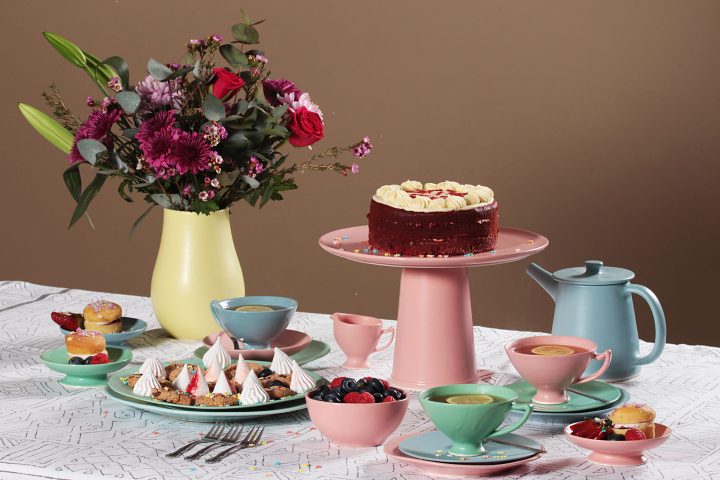
There’s more to presenting food than just sloshing it on the nearest plate to hand. And the plate you choose to present it on plays a bigger role than you might think.
Mervyn Gers Ceramics is internationally renowned for its one-of-a-kind ceramic pieces and handmade dinnerware. It began as a combination of a hobby and a love of ceramics; now it is a three-storey factory in Paarden Eiland with 47 employees which ships unique items all over the world – and to some of South Africa’s finest restaurants.
That we “eat first with our eyes” and beautiful presentation is critical when serving food is nothing new. But let’s take that a little further and look at what the food is on.
There are countless (because I’m not looking this up) options, whether you’re a home cook, a food stylist, Instagrammer, fancy dinner party host, or a restaurant. There are myriad (10,000 in classical history but who’s counting) ways to make that meal look the best it can. Did you know, though, that the colour of the plate can affect how much you eat?
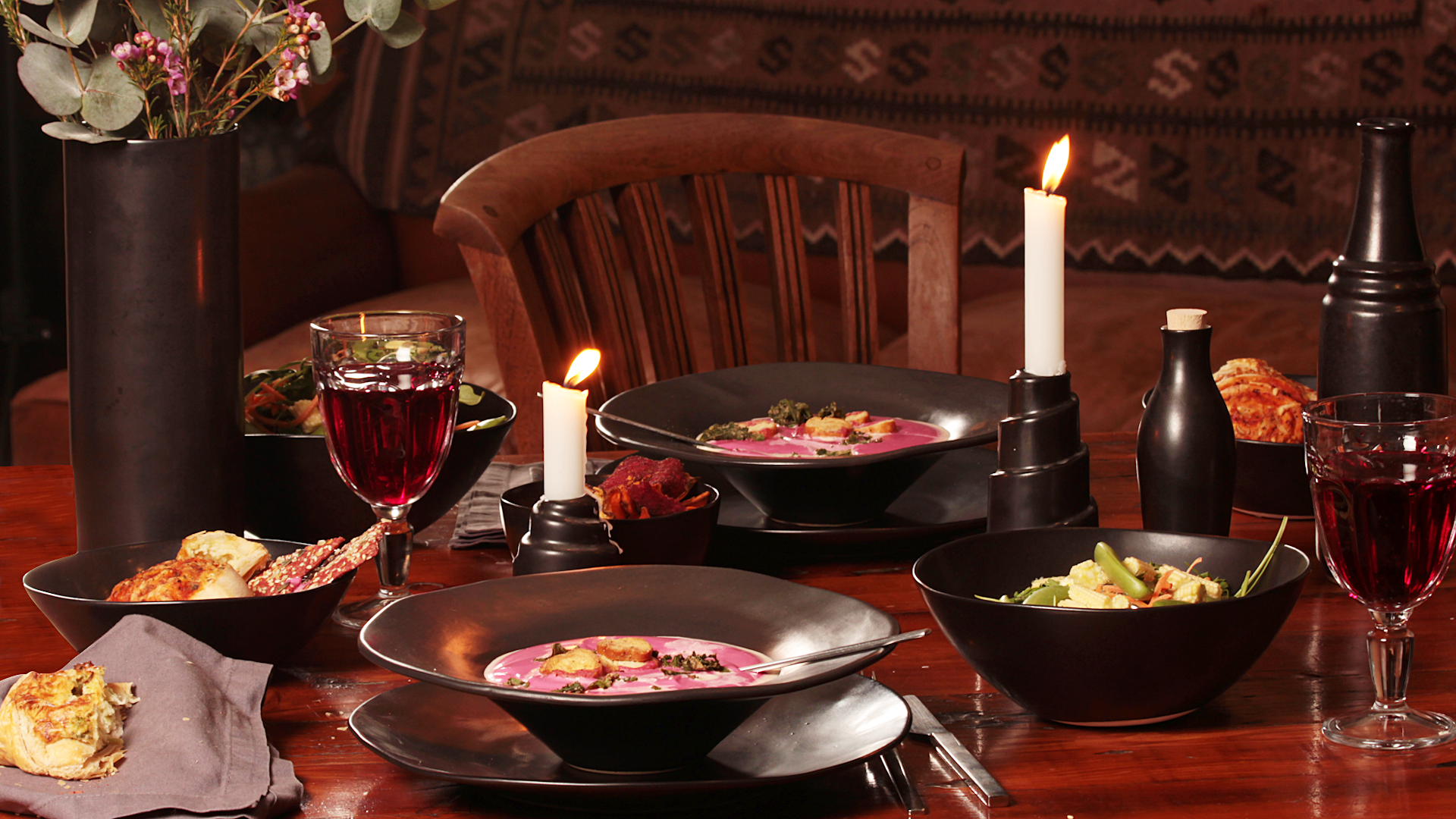
For a dramatic dinner, choose contrasting colours for food and dinnerware to make a bold statement on the table. (Photo: Supplied)
High contrast between the plate and the food will mean you’re likely to eat less; for example, pasta off a black plate as opposed to a white one. Red and blue plates in particular are singled out as being good if you’re trying to lose weight because, according to one report, red signals danger, while in another, blue acts as an appetite suppressant because it’s not associated with cravings in the brain. This is all nonsense, not only because you can Google until you find the answer you’re looking for, but back in the day when I had hangovers for which the only cure was McDonald’s (yes, I know, I’m suitably ashamed but too much Jack Daniel’s will do that), I would further punish myself by tipping it out on a red plastic plate. I always ate it all.
Thank the food gods those days are over. Now I can instead boast that I have Mervyn Gers ceramics in my home. This means I am in the same good taste ranks as Jan Hendrik van der Westhuizen, who has these ceramics at his Klein Jan restaurant in the Kalahari. Other places you will see this dinnerware include Koi Restaurant, Schoon, Marble, Homespun, Tjing Tjing, Salsify @ The Roundhouse, Mazza, and Boschendal – among many more.

Mervyn Gers Ceramics supplied all the tableware for Liam Tomlin’s restaurant Mazza. (Photo: Claire Gunn Photography)
The magic happens at a three-storey factory in Paarden Eiland, where every part of the manufacturing process takes place. Mervyn Gers Ceramics makes its own clay from a secret recipe which is constantly being refined, and tested for quality, shrinkage and strength with the help of the UCT chemical engineering department.
The clay is rolled out into slabs and goes either to a potter on a wheel, or to the team which uses moulds. At this stage it is called “greenware”, which simply means it has not yet been fired in a kiln. The fettlers smooth all the edges then into the oven it goes, at 1,000 degrees, for 24 to 48 hours, depending on the size of the item. It’s then called biscuit, or bisque ware, until it’s glazed. This is what gives the ceramic its colour, before it goes back in the kiln at around 1,200 degrees.
“Pinks, reds, oranges and yellows we do with stains, which gives a flat colour. If you use metal oxide, you get colours that are alive – the blues and greens. I prefer those,” said Mervyn Gers, who is a real person and not merely a brand name. Although he is that too.
Cadmium can give the warm hues depth, but it’s poisonous, so that’s not ideal. “We don’t work with lead or cadmium. Everything we do is food safe,” said Gers.

Mervyn Gers is a real person, not just a brand name. (Photo: Supplied)
Glazes are inspired by the varied southern Africa landscapes and are evocatively named Bakoven, Blouberg, Blue Onyx, Churchhaven, Fern, Fynbos, Green Onyx, Harbour, Langebaan, Madumbe, Monkey Apple, Moss, Ostrich Egg, Paternoster, Pond, Rock Pool and Veld.
The next step is the application of transfers – patterns like flowers, for instance – and another firing at a gentle 780 degrees. If there’s metallic detail like gold or platinum, that’s another application and firing. The finished product is sanded at the bottom so it doesn’t mess up your dining room table or sideboard or whatever, and stamped to identify it; some products are made specifically for restaurants or game lodges, in their exclusive colours and styles.
Even the packaging is made here, and is recyclable. In all, from start to finish, your bowl will pass through more than 20 pairs of hands, and depending on what you’re after, it can take four to eight weeks to deliver.
Buy off the shelf if you will, or choose an existing design, but you can consult with Gers with your own individual or personal design, or have him create one for you. That goes for colours, shapes and prints, whether you want one plate or a set for a royal banquet.
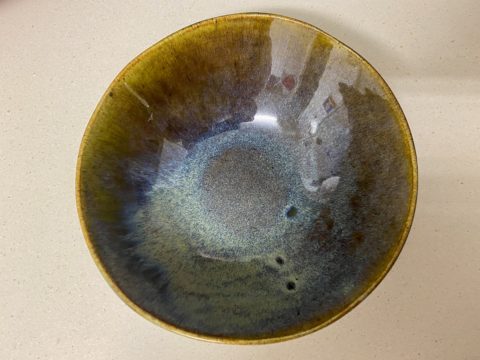
Bianca’s favourite bowl in her own collection, shimmering with the blues and greens imbued by metal oxide. (Photo: Bianca Coleman)
Either way, you will be getting one-of-a-kind works of art, each made by hand. It’s not an overstatement to call it that, especially when you learn the raw materials alter over time – such as a colour no longer being made the same way in the identical shade. One day my beautiful blue-green shimmery bowl will probably never be able to be replicated, and that’s rather special.
New from Mervyn Gers Ceramics is a range of chic candleholders, and I was pleased to learn that Gers himself said “some can also be used as flower vases” so I didn’t feel so bad about putting sprigs of jasmine in them.

For a dramatic dinner, choose contrasting colours for food and dinnerware to make a bold statement on the table. (Photo: Supplied)
Collaborations are the name of the game, and a contract with Antwerp-based fashion label, Bernadette, has resulted in ceramics being added to the spring 2021 collection. A mother and daughter creative duo, Bernadette and Charlotte de Geyter, the prints are painted by Charlotte. Mervyn Gers Ceramics’ glaze colours are symbiotic with those prints, said Gers. The factory is currently filled with vases, plates, cups, saucers and bowls in two of Bernadette’s popular designs: a red and pink poppy I am crazy about, and an ivory with pink and green rose bunches, with subtle gold detail.

The range for Antwerp-based fashion label Bernadette features two of the brand’s most popular floral prints – a red and pink poppy and an ivory with pink and green rose bunches. (Photo: Bernadette Antwerp)
Confirming the versatility of ceramics, Gers is also working with artist Richard Scott, initially launching a set of four cappuccino cups and saucers, and plenty more to come. It’s okay too if you drink tea or ordinary coffee out of these cups; I think the idea is to love and use all these items, not keep them wrapped up in a cupboard, even if some, like these, are limited editions.
Scott is known for his “naive meets pop” take on art and the colours and distinctive black lines translate beautifully on to ceramics, said Gers.
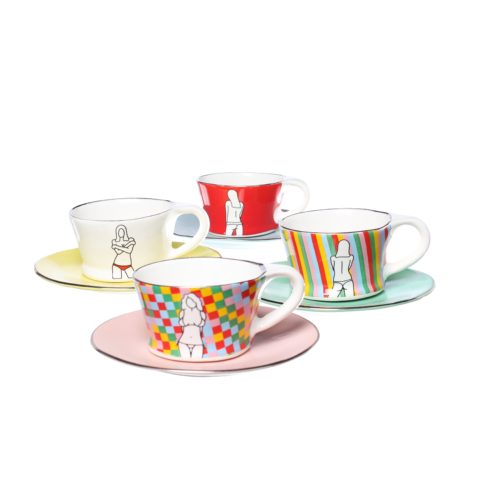
The collaboration with artist Richard Scott begins with an initial range consisting of a set of four cappuccino cups with saucers. (Photo: Supplied)
“Collaborations are key to success,” said Scott. “Mervyn is a smart guy and shares his knowledge freely. That’s one of the lessons in life that elevates you. Shape, colour, texture, feel, and design are all things that come naturally to Mervyn.”
The shape and style of Gers’s existing cappuccino cups appealed to Scott, who loves to drink coffee, so the match was perfect. “The rest was easy,” he said.
Behind the scenes, Gers is all about sustainable employment, with 47 staff members including himself. Before taking over the current premises – then only the one floor, a previous ceramics factory – Gers had been working from home. “I never thought I could afford it but we work with the Cape Design Institute, which gets funding from the Department of Trade and Industry. If you create jobs, you are eligible for R20,000 per position. But you can’t use it for salaries or materials or electricity. You can, however, use it to increase productivity, such as more kilns or installing air conditioning. It’s not a huge amount but it does help. One job in the Western Cape has an impact on 4.7 people. I think the only way to make a difference is to create jobs, and skills transfer. We train 95% of our staff from scratch.”
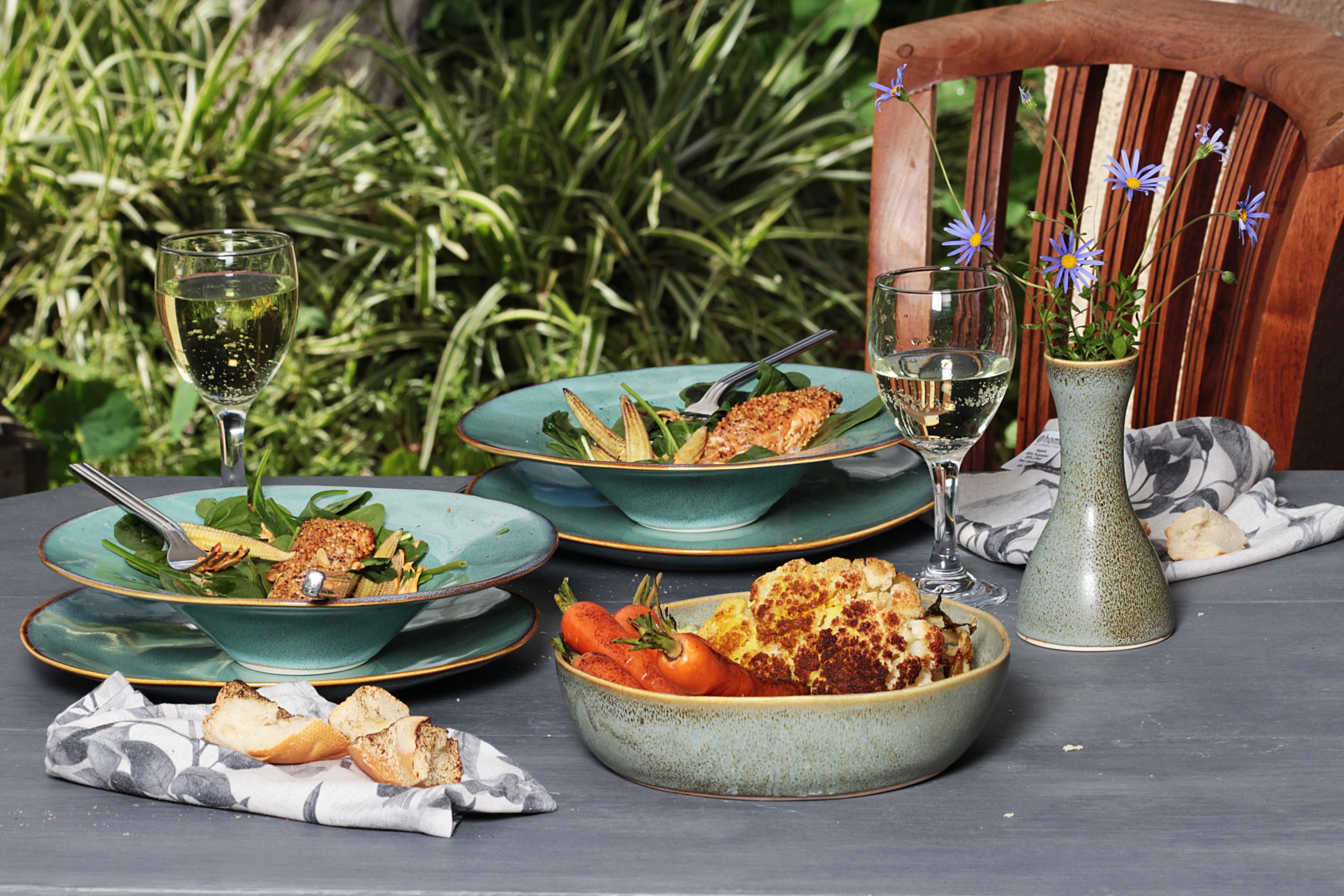
Minuscule differences in every piece are the mark of handmade ceramics – every one of them is unique. (Photo: Supplied)
In his previous life, Gers was hired by the SABC to set up Radio Kontrei, which later became Kfm. When the station later became privatised, Gers took his shares and left and became, in his words, unemployable: “White male, 40, small industry, 2001. So I started building and renovating houses, and selling them.”
Why ceramics? “I did classes once a week for a while but you can’t do much; it takes a year to finish something. It would start collapsing, or I would get bored. I always collected ceramics, and love 1970s decor. I wanted to do something creative and I didn’t know what the fuck else to do.”
The big Japanese-style pieces Gers made didn’t really sell, and cost time and effort. “Then I thought I could do the dinnerware and be able to afford to pursue the art.”
Gers moved into the factory in 2011, and now look: he’s famous.
“You don’t think about these things,” he said. “You start and it grows organically so you go with the flow and see what happens. Ceramics is such a wide field and I literally know that much still,” he said, pinching his thumb and forefinger together.
We can’t wait to see what happens when he knows more. DM/TGIFood
Mervyn Gers Ceramics supplies dinnerware for the styling of some TGIFood shoots. For more information, click here.
There’s much more from Tony Jackman and his food writing colleagues in his weekly TGIFood newsletter, delivered to your inbox every Friday. Subscribe here. Also visit the TGIFood platform, a repository of all of 0ur food writing.
The writer supports Holonathi, a distributor and manufacturer of fortified nutritional products for vulnerable children and families who don’t have access to good food.






 Become an Insider
Become an Insider
Good to hear a local success story.